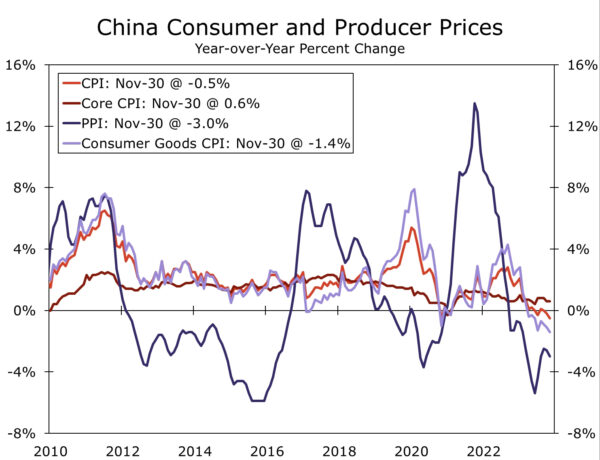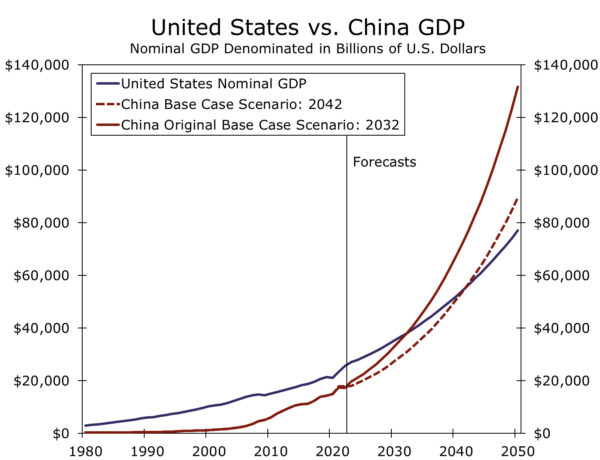Summary
The U.S. economy remains the largest economy in the world. But, will the U.S. be able to maintain that status forever? In our view, the answer is no. We believe China is on a path to eventually overtake the U.S. and become the world’s largest economy. However, China’s structural challenges and vulnerabilities combined with tense geopolitical relations are taking a greater toll on the economy than we previously expected and earlier than originally anticipated. So, while China’s rise to the world’s largest economy is inevitable, reaching the top of the economic throne will likely take longer than we previously estimated.
China’s Rise To The World’s Largest Economy Is Delayed
Over the years, we have expressed a pessimistic outlook toward China’s economy in multiple forums. Most recently, we highlighted the challenges that China faces in our 2024 International Economic Outlook publication. Our 2024 outlook mentions the fact that China has severe demographic problems, specifically a shrinking overall population as well as a dwindling labor force. In addition, we commented on how China’s ongoing real estate crisis, deflation, elevated corporate sector debt and softening consumer demand are likely to contribute to a sharp slowdown in growth prospects. Tack on an unclear outlook for the overall direction of economic policy as well as geopolitical tensions that has China being removed from global supply chains and the country being questioned as an investment destination, and China’s growth outlook is not particularly robust. In our view, the days of double-digit real GDP growth—even annual growth of 6%—are likely in the past. We do, however, believe China’s economy will continue to grow at a faster pace than the United States, both in nominal and real terms, going forward. Which is why we continue to believe China will ultimately overtake the U.S. and at some point become the largest economy in the world. With that said, these structural issues are taking a bigger toll on China’s economy than we previously expected, and that impact is materializing perhaps earlier than we initially thought. At the beginning of 2022, we published a report suggesting China could become the world’s largest economy in 2032. Under a set of economic and FX views as well as longer-term assumptions, we believed China would ascend to the largest economy in the world in ten years as nominal GDP growth would outpace the U.S. well into the next decade. However, the way China’s economy and financial markets have evolved, as well as the evolution of geopolitical trends, in our view mean that China’s rise to the economic throne will likely be delayed. In fact, under our forecasts and assumptions for both China and the United States, we still believe China will overtake the U.S.; however, rather than the ascension taking place in 2032, our new estimate is 2042,10 years later than our original timeline.
Our revised estimate is rooted in a Chinese economy that has underperformed even relative to our already pessimistic outlook. Over the last few years, China has been plagued by a number of developments that has pushed out the timeline for challenging the U.S. in economic size. These developments include a short-lived post “Zero-COVID” rebound in activity, a weaker renminbi than we previously forecast, worsening geopolitical relations due to exogenous military conflicts in Europe and the Middle East, and structural imbalances that have intensified more than expected. In addition, and perhaps a consequence of those developments, inflation has fallen rapidly to the point that China is currently experiencing deflation (Figure 1). As of November, CPI is -0.5% year-over-year, well below China’s long-run average inflation rate of around 2%. Deflation is arguably one of the primary drivers, in addition to a U.S. economy that has outperformed recently, why China will now take an additional decade to become the world’s largest economy. Not only can deflation place additional pressure on already sluggish consumer spending and contribute to softer activity, but deflation will contribute to lower nominal GDP growth. Going forward, we believe China’s economy will continue to decelerate and inflation will remain rather subdued. We expect many of China’s structural issues and tail-risks to remain in place (i.e. a real estate induced financial crisis, invasion of Taiwan etc.); however, our base case scenario for China does not include a large-scale crisis unfolding. Rather, we believe Chinese authorities will pursue policies consistent with supporting the economy over the next few years, although more accommodative policy will, in our view, do little to change the direction of China’s economy or alter underlying trends. As a result of shifting to more accommodative policy, we assume authorities will further pause its deleveraging campaign. Leverage has historically been a growth mechanism for China’s economy; however, with the local real estate sector under pressure, we have our doubts deploying fiscal resources toward property development will yield more than only marginal benefits. We also assume the impact of an aging population and diminishing workforce will continue to weigh on growth prospects, while China slowly being removed from the global marketplace will disrupt China’s current export driven economic model. Periods of deflation and subdued inflation, as well as high household saving rates, are also likely to keep consumer spending subdued and contribute to slower growth.
Under these assumptions, we forecast China’s economy to grow 5.2% in 2023, 4.5% in 2024 and 4.3% in 2025. On the inflation side, we believe the CPI will rise 0.4% in 2023, 1.5% in 2024 and 1.8% in 2025. Combining our GDP and CPI forecasts, we expect China’s economy to experience nominal GDP growth of ~5.5%-6% through the end of 2025. Relative to our initial estimate of when China could overtake the U.S. economy, our short-term nominal GDP forecasts have been revised lower to reflect a worsening of structural economic challenges and intensifying downside risks. Longer-term, we believe structural issues will remain intact and nominal GDP growth will slow. From 2026-2030 we assume average nominal GDP growth of 5.8% (4% real GDP growth & 1.8% rise in CPI). Over the course of the 2030s, we assume average nominal GDP growth of 5.3% (3.5% real GDP growth and 1.8% rise in CPI) and 4.8% nominal growth in the 2050s (3% real GDP growth and 1.8% rise in CPI). Our longer-term growth and inflation assumptions have also been revised lower as economic trends and vulnerabilities have worsened. As far as the United States, the U.S. economy was able to avoid recession in 2023 despite high inflation and elevated interest rates. The resiliency of the U.S. economy also contributes to China becoming the world’s largest economy a decade later than our prior estimate. Going forward, our U.S. economists forecast the U.S. economy to expand at a nominal GDP growth rate of 6.2% in 2023, 3.1% in 2024 and 3.6% in 2025. Our colleagues also estimate that average nominal GDP growth for the U.S. economy is likely to be 4% over the long-term. Using these forecasts and long-run estimates for growth and inflation, China’s nominal GDP could rise to a little over RMB296T by 2042. United States nominal GDP could rise to $56.5T by the same year.
But, in order to make a fair comparison of nominal GDP levels, China’s nominal GDP must be converted into U.S. dollars. Exchange rate assumptions and the path of the renminbi can play a pivotal role in determining when, or if, China overtakes the United States. In our view, the Chinese renminbi is likely to strengthen over the next few decades. We believe authorities will gradually lift capital controls and play a reduced role in FX markets in an effort to have the renminbi gather momentum as a reserve currency and take a larger role in the global marketplace. In order for the renminbi to become more widely used, the currency will need to become market driven rather than influenced by the People’s Bank of China and other local authorities. Most currency valuation methodologies indicate the renminbi is undervalued, likely due to capital controls and other regulations. Should controls and restrictions be lifted over time, the renminbi could strengthen toward “fair value” and facilitate China becoming the world’s largest economy. Incorporating our long-term RMB view, as well as our GDP and inflation assumptions, China’s nominal GDP, converted into U.S. dollars, could rise to a little over $57.5T by 2042, leaving China as the world’s largest economy in a little less than 20 years—a more gradual ascent than the 10-year horizon we previously envisaged (Figure 2).
















